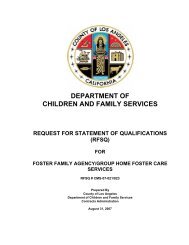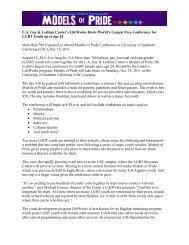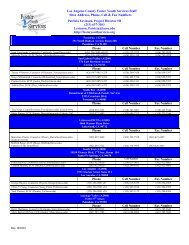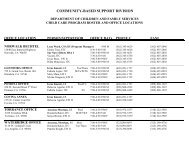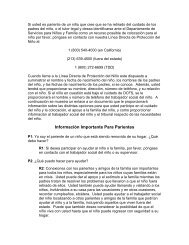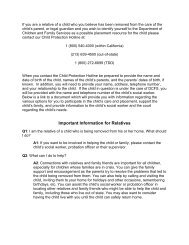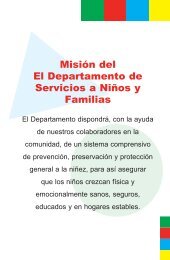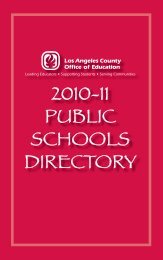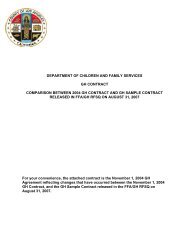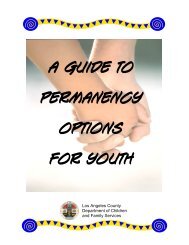Phases and Activities of the Wraparound Process - Los Angeles ...
Phases and Activities of the Wraparound Process - Los Angeles ...
Phases and Activities of the Wraparound Process - Los Angeles ...
You also want an ePaper? Increase the reach of your titles
YUMPU automatically turns print PDFs into web optimized ePapers that Google loves.
<strong>Phases</strong> <strong>and</strong> activities <strong>of</strong> <strong>the</strong> wraparound process 8<br />
<strong>Phases</strong> <strong>and</strong> <strong>Activities</strong> <strong>of</strong> <strong>the</strong> <strong>Wraparound</strong> <strong>Process</strong>: Phase 2<br />
MAJOR TASKS/Goals ACTIVITIES NOTES<br />
PHASE 2: Initial plan development<br />
During this phase, team trust <strong>and</strong> mutual respect are built while <strong>the</strong> team creates an initial plan <strong>of</strong> care using a high-quality planning process that reflects<br />
<strong>the</strong> wraparound principles. In particular, youth <strong>and</strong> family should feel, during this phase, that <strong>the</strong>y are heard, that <strong>the</strong> needs chosen are ones <strong>the</strong>y want to<br />
work on, <strong>and</strong> that <strong>the</strong> options chosen have a reasonable chance <strong>of</strong> helping <strong>the</strong>m meet <strong>the</strong>se needs. This phase should be completed during one or two<br />
meetings that take place within 1-2 weeks, a rapid time frame intended to promote team cohesion <strong>and</strong> shared responsibility toward achieving <strong>the</strong> team’s<br />
mission or overarching goal.<br />
2.1. Develop an initial plan <strong>of</strong><br />
care<br />
GOAL: To create an initial plan <strong>of</strong><br />
care using a high-quality team<br />
process that elicits multiple<br />
perspectives <strong>and</strong> builds trust <strong>and</strong><br />
shared vision among team<br />
members, while also being<br />
consistent with <strong>the</strong> wraparound<br />
principles<br />
2.1 a. Determine ground rules<br />
Facilitator guides team in a discussion <strong>of</strong> basic ground<br />
rules, elicits additional ground rules important to team<br />
members, <strong>and</strong> facilitates discussion <strong>of</strong> how <strong>the</strong>se will<br />
operate during team meetings. At a minimum, this<br />
discussion should address legal <strong>and</strong> ethical issues—<br />
including confidentiality, m<strong>and</strong>atory reporting, <strong>and</strong> o<strong>the</strong>r<br />
legal requirements—<strong>and</strong> how to create a safe <strong>and</strong> blamefree<br />
environment for youth/family <strong>and</strong> all team members.<br />
Ground rules are recorded in team documentation <strong>and</strong><br />
distributed to members.<br />
2.1 b. Describe <strong>and</strong> document strengths<br />
Facilitator presents strengths from <strong>the</strong> summary document<br />
prepared during phase 1, <strong>and</strong> elicits feedback <strong>and</strong><br />
additional strengths, including strengths <strong>of</strong> team members<br />
<strong>and</strong> community.<br />
2.1 c. Create team mission<br />
Facilitator reviews youth <strong>and</strong> family’s vision <strong>and</strong> leads<br />
team in setting a team mission, introducing idea that this is<br />
<strong>the</strong> overarching goal that will guide <strong>the</strong> team through<br />
phases <strong>and</strong>, ultimately, through transition from formal<br />
wraparound.<br />
A Product <strong>of</strong> <strong>the</strong> National <strong>Wraparound</strong> Initiative – October 10, 2004 version<br />
In this activity, <strong>the</strong> team members define <strong>the</strong>ir collective<br />
expectations for team interaction <strong>and</strong> collaboration.<br />
These expectations, as written into <strong>the</strong> ground rules,<br />
should reflect <strong>the</strong> principles <strong>of</strong> wraparound. For<br />
example, <strong>the</strong> principles stress that interactions should<br />
promote family <strong>and</strong> youth voice <strong>and</strong> choice <strong>and</strong> should<br />
reflect a strengths orientation. The principles also<br />
stress that important decisions are made within <strong>the</strong><br />
team.<br />
While strengths are highlighted during this activity, <strong>the</strong><br />
wraparound process features a strengths orientation<br />
throughout.<br />
The team mission is <strong>the</strong> collaboratively set, long-term<br />
goal that provides a one or two sentence summary <strong>of</strong><br />
what <strong>the</strong> team is working towards.



